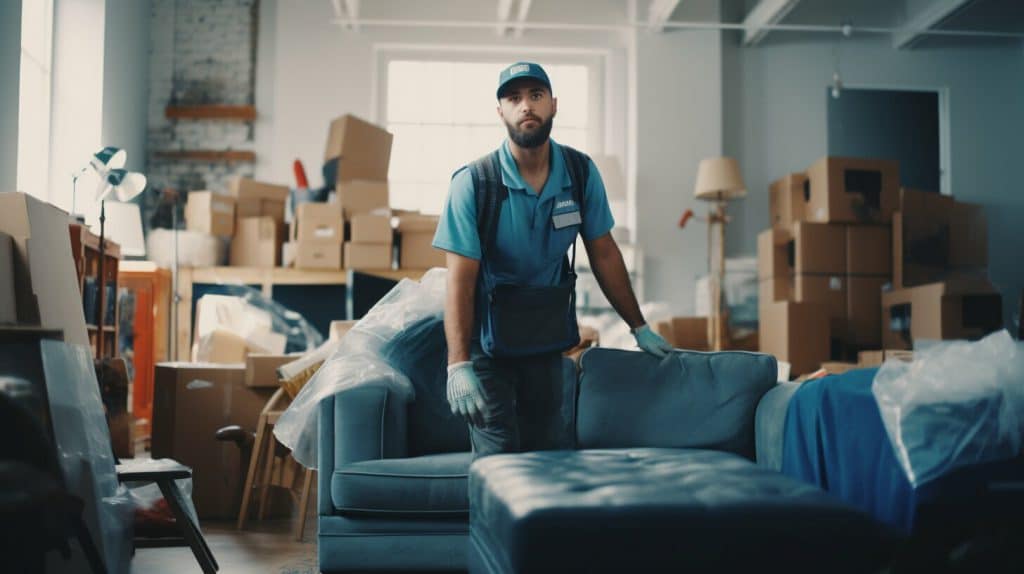Moving from New York to San Francisco can be an exciting adventure, but it also requires careful planning. Whether you are relocating for work or personal reasons, there are several factors you should consider before making the move. One of the key factors to keep in mind is the cost of living differences between the two cities.
In addition to the cost of living, you may also want to consider the benefits of using relocation services for your cross country move. These services can help streamline the process and ensure a smoother transition to your new home in San Francisco.
Key Takeaways:
- The cost of living in San Francisco is generally higher than in New York, particularly in areas such as housing and transportation
- Using relocation services can help ease the logistics of your move and provide additional support during the transition period
- Choosing the right moving company is essential for a successful cross-country move
- Packing efficiently and organizing your belongings can help make the move smoother
- Understanding the moving process and timeline can help ensure a successful move
Cost of Living Comparison: New York vs. San Francisco
When planning a long distance move from New York to San Francisco, it's important to have a clear understanding of the cost of living differences between the two cities. Housing, transportation, groceries, and other essential expenses can vary significantly, and it's important to factor in these differences when budgeting for your move. This is where professional movers and reputable moving companies can come in handy, helping you to navigate these differences with ease.
Housing Costs: San Francisco is known for its high cost of living, and this extends to housing as well. The median home price in San Francisco is around $1.3 million, while in New York City it is around $680,000. Renting is also more expensive in San Francisco, with a one-bedroom apartment costing around $3,500 per month compared to $2,800 in New York City.
Transportation Costs: San Francisco has a comprehensive public transportation system, with the cost of a monthly pass for unlimited travel costing around $98. In contrast, New York City's monthly pass costs approximately $127. Gas prices are also higher in San Francisco, with an average price of around $4.20 per gallon compared to $3.00 per gallon in New York City.
Grocery Costs: Groceries are generally more expensive in San Francisco than in New York City. For example, a gallon of milk can cost up to $4.50 in San Francisco, while in New York City it is around $3.50.
Overall, when moving from New York to San Francisco, it's important to account for these differences in your budget. Hiring professional movers and reliable moving companies can help to ensure you're fully prepared for the transition.
Getting Accurate Moving Quotes
When planning a move from New York to San Francisco, obtaining accurate moving quotes is crucial for budgeting and managing costs. To ensure that you receive a realistic estimate and avoid any surprises on moving day, there are several factors to consider.
Factors That Affect Moving Costs
The cost of your move is impacted by several factors:
- The distance between your current location in New York and your new home in San Francisco
- The amount of belongings you plan to move
- The need for packing and unpacking services
- Special handling requirements for fragile or valuable items
- Storage requirements, if any
When requesting quotes from moving companies, be sure to provide accurate information regarding the above factors. This will ensure that the quotes you receive are as close to the final cost as possible.
Moving Checklist
To streamline the process of obtaining quotes, it is important to create a comprehensive moving checklist. This checklist should include:
- The date of your move
- The size of your home and the number of rooms
- A list of all major items and furniture that will be moved
- Any items requiring special handling or care
- Whether you will require packing and unpacking services
- Whether you will require storage services
By providing this information to moving companies, you can ensure that you receive accurate quotes that reflect the specifics of your move. Be sure to compare quotes from multiple companies to find the best price and customer service for your move from New York to San Francisco.
Choosing the Right Moving Company
When it comes to a cross-country move from New York to San Francisco, choosing the right moving company is crucial. You want a company that offers reliable interstate moving services and provides packing and moving services to make your transition as smooth as possible. Here are some factors to consider:
Experience: Look for a moving company experienced in cross-country moves. They should have a thorough understanding of the logistics involved in moving long distances and be able to offer insights and solutions to potential challenges.
Reputation: Do your research and look for a moving company with a solid reputation. Read customer reviews and check with the Better Business Bureau to ensure the company has a good track record of providing quality service.
Services offered: Make sure the moving company offers the services you need, such as packing and unpacking, loading and unloading, and storage solutions. You want a company that can handle every aspect of your move and provide the support you require.
Cost: While cost should not be the only factor to consider, it is important to select a company that offers affordable pricing. Obtain quotes from multiple moving companies to compare prices and services offered, and make sure you understand any additional fees or charges that may apply.
By choosing the right moving company for your cross-country move from New York to San Francisco, you can ensure a smooth transition and enjoy peace of mind throughout the process.
Tips for a Smooth Move
When moving from New York to San Francisco, working with a reputable moving company is key to ensuring a smooth transition. Consider hiring full-service movers to handle the logistics of packing, loading, and unloading your belongings. These professionals have the experience and equipment to handle large and fragile items with care, ensuring that everything arrives at your new home in San Francisco intact.
Prior to packing, declutter your home to make moving more efficient. Sort through your belongings and donate or sell items that you no longer need or use. This will also help reduce the cost of your move, as movers typically charge by weight.
Label your boxes clearly and pack them in a logical order, grouping similar items together. This will make it easier to unpack and organize your belongings once you arrive in San Francisco.
Be sure to communicate any special requirements or requests to your moving company in advance. This could include fragile items that require extra care or specific delivery dates. Working with a reliable moving company that prioritizes clear communication can make all the difference in a successful move.
Understanding the Moving Process
Long-distance moving from New York to San Francisco can be an overwhelming and exhausting process. To ensure a successful move, it is crucial to understand the necessary preparations, logistics, and timelines involved. Here, we will provide a step-by-step guide to help you navigate the moving process smoothly.
Step 1: Planning Your Move
The first step in a long-distance move is to plan ahead. It is essential to determine your moving budget and find affordable moving options that fit your needs. Research moving companies from New York to San Francisco and compare their rates and services. Consider the cost of living differences between the two cities and budget accordingly.
Step 2: Packing and Organizing Belongings
Packing efficiently is key to a successful move. Begin packing non-essential items as early as possible and use sturdy boxes and packing materials. Label boxes clearly to keep track of your belongings and organize them according to their destination in your new home. Consider hiring full-service movers to assist with your packing and moving needs.
Step 3: Utilities and Address Changes
Before you move, be sure to cancel your current utilities in New York and set up new ones in San Francisco. Notify your bank, credit card companies, and other essential services of your address change. Update your mailing address with the USPS and other necessary parties.
Step 4: Hiring a Reputable Moving Company
Choosing the right moving company is critical to a successful move. Look for moving companies that are experienced in long-distance moves from New York to San Francisco and offer reliable interstate moving services. Check customer reviews and ratings to ensure their reputation is trustworthy and professional.
Step 5: Moving Day Logistics
On moving day, ensure that you have all necessary paperwork and documentation on hand, such as your moving contract and inventory list. Verify that all items are loaded onto the moving truck and keep a record of their condition. Communicate with your movers throughout the process to ensure a smooth and stress-free move.
Step 6: Settling into Your New Home
Once you arrive in San Francisco, it is time to settle into your new home. Unpack efficiently and prioritize essential items such as bedding and kitchenware. Set up your utilities and familiarize yourself with your new neighborhood. Hiring professional movers from New York to San Francisco can make this process much more manageable, allowing you to focus on settling in and adjusting to your new surroundings.
By following these steps and utilizing the right resources, you can make your long-distance move from New York to San Francisco both affordable and stress-free.
Settling into San Francisco
Once you arrive in San Francisco, it's time to start settling into your new home. This process can be overwhelming, but with the help of professional movers from New York to San Francisco and interstate moving services, it can be much smoother.
The first step is to unpack and set up your new home. You may want to start by unpacking essential items, such as toiletries and bedding, before moving onto other items. Make sure to label boxes clearly to make the unpacking process easier.
Next, you'll need to set up utilities, such as electricity, gas, and internet. Contact the appropriate service providers to get these set up as soon as possible, so you don't have to wait too long to enjoy these essential amenities in your new home.
Getting acquainted with San Francisco is also important. Take some time to explore the city, both on your own and through organized tours. Visit popular tourist attractions, such as the Golden Gate Bridge, Alcatraz Island, and Fisherman's Wharf, as well as local neighborhoods and restaurants.
Working with professional movers from New York to San Francisco can make settling into your new home much easier. They can offer additional services, such as storage solutions, that can help you get organized and settled into your new home. You can focus on enjoying your new surroundings while they handle the logistics of your move.
Relocation Services to Ease Your Transition
Relocating from New York to San Francisco can be daunting, but utilizing reliable moving services can ease your transition. Cross-country moving from New York to San Francisco requires a lot of planning, and choosing the right moving company can make all the difference.
Reliable moving from New York to San Francisco is crucial to ensuring that your belongings arrive safely and on time. Moving can be stressful, so it is essential to have a trusted partner to handle the logistics and paperwork, allowing you to focus on settling into your new home in San Francisco.
Interstate moving companies experienced with long-distance moving from New York to San Francisco can provide extensive support, making the process smoother. These services may include packing and moving, storage solutions, and even assistance with settling in.
Why Use Relocation Services?
Relocation services offer numerous benefits, including:
- Efficient packing and moving
- Reduced stress and hassle
- Professional advice and guidance
- Access to a network of reliable movers and partners
- Savings in time and money
By choosing cross-country moving from New York to San Francisco with a reputable moving company, you can experience a worry-free relocation. These services provide personalized support tailored to your specific needs, ensuring a successful move to your new home in San Francisco.
Long-Distance Moving Companies: What to Look For
When planning a move from New York to San Francisco, choosing the right moving company is crucial. With so many moving companies available, it can be challenging to determine which one is the best fit for your specific needs. Here are some important factors to consider when selecting a long-distance moving company for your move from New York to San Francisco:
Reputation
Look for a company with a solid reputation for providing high-quality service. Check customer reviews and ratings on reputable websites like the Better Business Bureau to ensure that the company has a track record of delivering on their promises.
Experience
Choose a company with experience in long-distance moves, particularly those that have experience with moves from New York to San Francisco. This experience will ensure that the company is able to navigate any potential challenges unique to this route.
Services Offered
Consider the services offered by the company. Do they offer packing and moving services? Do they provide storage options? Do they have experience with interstate moves? Knowing the full range of services available can help you make the best decision.
Licensing and Insurance
Ensure that the company is fully licensed and insured. This will protect your belongings in the event of any accidents or damage during the move.
Moving Tips
When preparing for your move from New York to San Francisco, there are some tips to keep in mind. Take inventory of all your belongings, discard any items you no longer need, and pack carefully to ensure that your belongings arrive safely at your new home. Additionally, be sure to book your moving company well ahead of time to ensure availability.
By considering these factors when selecting a long-distance moving company, you can find a reliable partner to make your move from New York to San Francisco a success.
Conclusion
Moving from New York to San Francisco is a significant undertaking that requires careful planning, organization, and the right moving company. With the cost of living being a key consideration, it's important to compare expenses in both cities to ensure you have a realistic budget for your move.
Long-distance moving can be stressful, but utilizing relocation services, obtaining accurate moving quotes, and selecting a reputable moving company can go a long way in easing the process. Full-service movers can make sure that your belongings are packed efficiently and arrive at your new home in San Francisco safely.
It's important to understand the moving process and timelines involved in a cross-country move. Once you have arrived in San Francisco, it's important to settle in and get acquainted with the city. Professional movers can assist with unpacking, setting up utilities, and any other logistics necessary for your move.
When choosing a long-distance moving company, consider their reputation, experience, and customer reviews. Keeping these factors in mind, along with important moving tips specific to this route, can ensure that you choose the right company for your move.
In summary, cross-country moving from New York to San Francisco may seem overwhelming, but with planning, organization, and the right moving company, it can be a successful and smooth transition.
FAQ
Q: What factors should I consider when planning a move from New York to San Francisco?
A: When planning a move from New York to San Francisco, it is important to consider the cost of living differences, housing options, transportation, and essential expenses in both cities. Additionally, utilizing relocation services can greatly ease your cross-country move.
Q: How does the cost of living in New York compare to San Francisco?
A: New York and San Francisco have different costs of living, particularly when it comes to housing, transportation, groceries, and other essential expenses. It is important to research and compare these factors before making your move.
Q: How can I obtain accurate moving quotes for my move?
A: To obtain accurate moving quotes, it is crucial to provide moving companies with the necessary information such as the size of your home, the distance of your move, and any additional services you may require. This will ensure that you receive accurate quotes tailored to your specific needs.
Q: What should I consider when choosing a moving company for my move?
A: When choosing a moving company for your move from New York to San Francisco, it is important to select a company with experience in cross-country moves, reliable interstate moving services, and a range of packing and moving services to suit your needs.
Q: What tips can you provide to make my move go smoothly?
A: To ensure a smooth move, it is important to pack efficiently, organize your belongings, and consider working with full-service movers who can handle the logistics of your move. Additionally, following a moving checklist and staying organized will help streamline the process.
Q: What is involved in the moving process from New York to San Francisco?
A: The moving process from New York to San Francisco involves careful preparations, logistics planning, and timelines. It is important to understand the steps involved in a long-distance move and consider affordable moving options that suit your budget.
Q: How can I settle into San Francisco after my move?
A: To settle into San Francisco after your move, it is important to unpack efficiently, set up utilities, and familiarize yourself with the city. Hiring professional movers can help ease the transition and ensure a smooth process of settling into your new home.
Q: What are the benefits of utilizing relocation services for my move?
A: Utilizing relocation services can greatly ease your transition from New York to San Francisco. These services provide assistance with logistics, paperwork, and other aspects of your cross-country move, allowing you to focus on settling into your new home.
Q: What should I look for in long-distance moving companies for my move?
A: When choosing long-distance moving companies for your move from New York to San Francisco, it is important to consider their reputation, experience, and customer reviews. Additionally, following specific moving tips for this route can help ensure a successful move.
Q: What are the key considerations when planning a cross-country move?
A: When planning a cross-country move, it is important to carefully consider the cost of living differences, select the right moving company, and make necessary preparations. By following these considerations, you can navigate the process more smoothly and enjoy a successful move.













